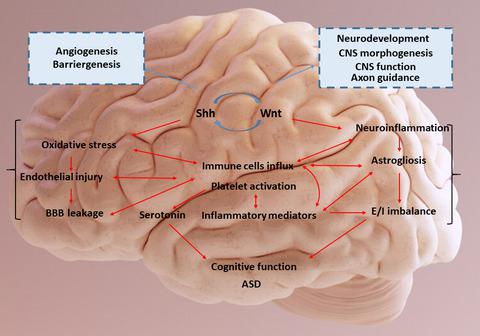当前位置:
X-MOL 学术
›
J. Neurochem.
›
论文详情
Our official English website, www.x-mol.net, welcomes your feedback! (Note: you will need to create a separate account there.)
Potential crosstalk between sonic hedgehog-WNT signaling and neurovascular molecules: Implications for blood–brain barrier integrity in autism spectrum disorder
Journal of Neurochemistry ( IF 4.7 ) Pub Date : 2021-06-25 , DOI: 10.1111/jnc.15460 Evelyne Gozal 1 , Rekha Jagadapillai 1 , Jun Cai 1 , Gregory N Barnes 1, 2
Journal of Neurochemistry ( IF 4.7 ) Pub Date : 2021-06-25 , DOI: 10.1111/jnc.15460 Evelyne Gozal 1 , Rekha Jagadapillai 1 , Jun Cai 1 , Gregory N Barnes 1, 2
Affiliation

|
Autism Spectrum Disorder (ASD) is a neurodevelopmental disease originating from combined genetic and environmental factors. Post-mortem human studies and some animal ASD models have shown brain neuroinflammation, oxidative stress, and changes in blood–brain barrier (BBB) integrity. However, the signaling pathways leading to these inflammatory findings and vascular alterations are currently unclear. The BBB plays a critical role in controlling brain homeostasis and immune response. Its dysfunction can result from developmental genetic abnormalities or neuroinflammatory processes. In this review, we explore the role of the Sonic Hedgehog/Wingless-related integration site (Shh/Wnt) pathways in neurodevelopment, neuroinflammation, and BBB development. The balance between Wnt-β-catenin and Shh pathways controls angiogenesis, barriergenesis, neurodevelopment, central nervous system (CNS) morphogenesis, and neuronal guidance. These interactions are critical to maintain BBB function in the mature CNS to prevent the influx of pathogens and inflammatory cells. Genetic mutations of key components of these pathways have been identified in ASD patients and animal models, which correlate with the severity of ASD symptoms. Disruption of the Shh/Wnt crosstalk may therefore compromise BBB development and function. In turn, impaired Shh signaling and glial activation may cause neuroinflammation that could disrupt the BBB. Elucidating how ASD-related mutations of Shh/Wnt signaling could cause BBB leaks and neuroinflammation will contribute to our understanding of the role of their interactions in ASD pathophysiology. These observations may provide novel targeted therapeutic strategies to prevent or alleviate ASD symptoms while preserving normal developmental processes.
中文翻译:

声波刺猬-WNT信号与神经血管分子之间的潜在串扰:对自闭症谱系障碍血脑屏障完整性的影响
自闭症谱系障碍(ASD)是一种由遗传和环境因素共同引起的神经发育疾病。验尸人体研究和一些动物 ASD 模型显示脑神经炎症、氧化应激和血脑屏障 (BBB) 完整性的变化。然而,导致这些炎症发现和血管改变的信号通路目前尚不清楚。BBB 在控制大脑稳态和免疫反应方面起着关键作用。它的功能障碍可能是由发育遗传异常或神经炎症过程引起的。在这篇综述中,我们探讨了 Sonic Hedgehog/Wingless 相关整合位点 (Shh/Wnt) 通路在神经发育、神经炎症和 BBB 发育中的作用。Wnt-β-catenin 和 Shh 通路之间的平衡控制血管生成、屏障生成、神经发育、中枢神经系统 (CNS) 形态发生和神经元引导。这些相互作用对于维持成熟 CNS 中的 BBB 功能以防止病原体和炎症细胞的流入至关重要。已在 ASD 患者和动物模型中发现了这些途径的关键成分的基因突变,这与 ASD 症状的严重程度相关。因此,Shh/Wnt 串扰的中断可能会损害 BBB 的发育和功能。反过来,受损的 Shh 信号传导和神经胶质激活可能会导致可能破坏 BBB 的神经炎症。阐明 ASD 相关的 Shh/Wnt 信号突变如何导致 BBB 渗漏和神经炎症将有助于我们理解它们在 ASD 病理生理学中相互作用的作用。
更新日期:2021-06-25
中文翻译:

声波刺猬-WNT信号与神经血管分子之间的潜在串扰:对自闭症谱系障碍血脑屏障完整性的影响
自闭症谱系障碍(ASD)是一种由遗传和环境因素共同引起的神经发育疾病。验尸人体研究和一些动物 ASD 模型显示脑神经炎症、氧化应激和血脑屏障 (BBB) 完整性的变化。然而,导致这些炎症发现和血管改变的信号通路目前尚不清楚。BBB 在控制大脑稳态和免疫反应方面起着关键作用。它的功能障碍可能是由发育遗传异常或神经炎症过程引起的。在这篇综述中,我们探讨了 Sonic Hedgehog/Wingless 相关整合位点 (Shh/Wnt) 通路在神经发育、神经炎症和 BBB 发育中的作用。Wnt-β-catenin 和 Shh 通路之间的平衡控制血管生成、屏障生成、神经发育、中枢神经系统 (CNS) 形态发生和神经元引导。这些相互作用对于维持成熟 CNS 中的 BBB 功能以防止病原体和炎症细胞的流入至关重要。已在 ASD 患者和动物模型中发现了这些途径的关键成分的基因突变,这与 ASD 症状的严重程度相关。因此,Shh/Wnt 串扰的中断可能会损害 BBB 的发育和功能。反过来,受损的 Shh 信号传导和神经胶质激活可能会导致可能破坏 BBB 的神经炎症。阐明 ASD 相关的 Shh/Wnt 信号突变如何导致 BBB 渗漏和神经炎症将有助于我们理解它们在 ASD 病理生理学中相互作用的作用。



























 京公网安备 11010802027423号
京公网安备 11010802027423号